Study Skills for Higher Education: Essay Assignment
VerifiedAdded on 2023/01/10
|11
|3392
|1
Essay
AI Summary
This assignment comprises two parts: an essay and a report. The essay delves into the difficulties students face in maintaining a work-life balance in college, exploring the impact of assignments, financial pressures, and lecture hours. It proposes effective study plans for time management and suggests ways to enhance reading skills, such as setting goals, skimming, and applying key reading strategies. The report focuses on learning styles, specifically the VARK model (Visual, Auditory, Reading/Writing, Kinesthetic), and their main features. It then explores additional strategies to enhance learning, catering to different learning preferences. Both sections aim to equip students with practical tools and insights to improve their academic performance and overall well-being. The document provides a comprehensive analysis of study skills essential for success in higher education.
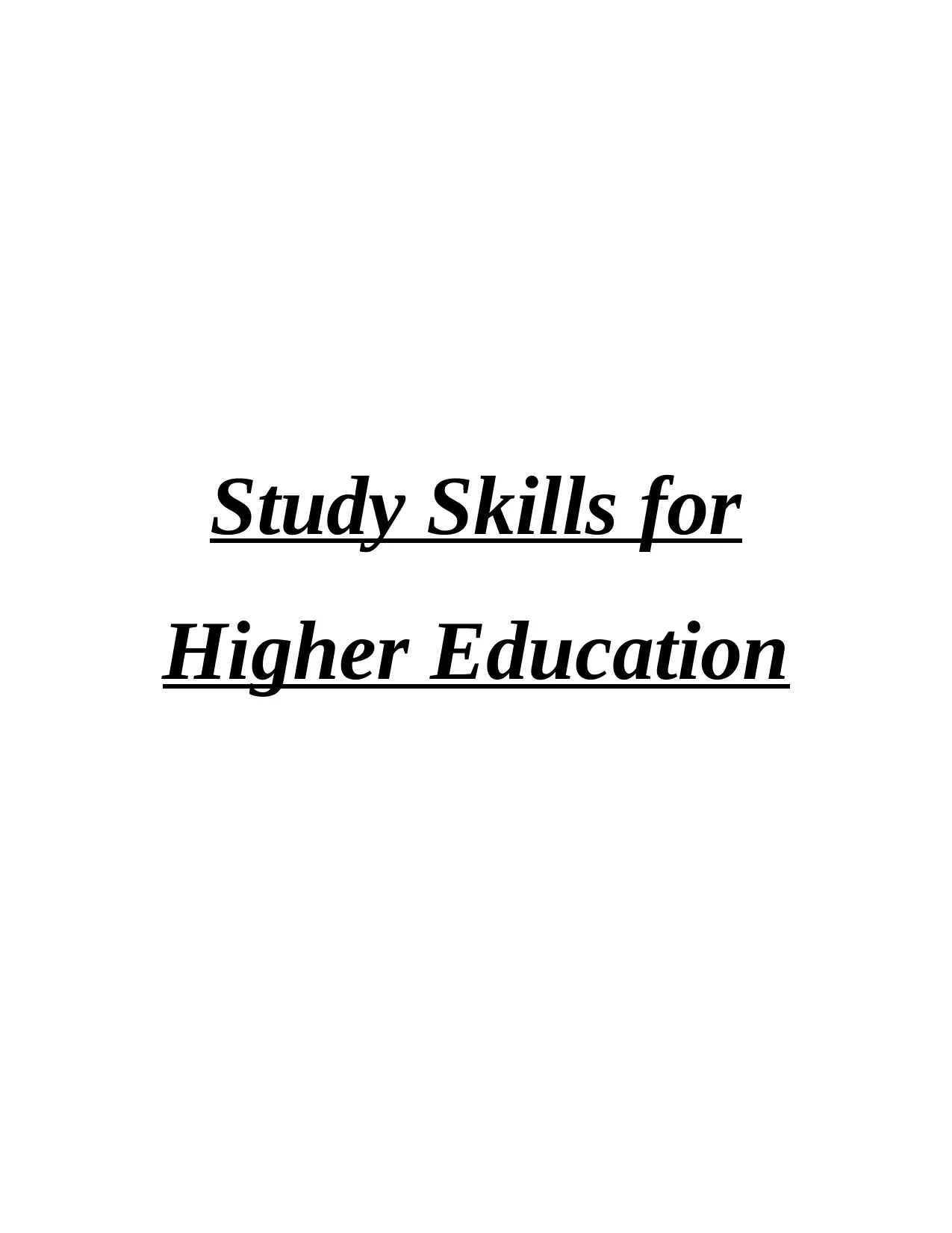
Study Skills for
Higher Education
Higher Education
Paraphrase This Document
Need a fresh take? Get an instant paraphrase of this document with our AI Paraphraser

Table of Contents
INDIVIDUAL ESSAY....................................................................................................................1
INTRODUCTION...........................................................................................................................1
MAIN BODY...................................................................................................................................1
Reasons behind difficulty to maintain a work life balance in college along with ways to
develop effective study plan........................................................................................................1
Ways to enhance reading skills...................................................................................................2
CONCLUSION................................................................................................................................3
REFERENCES................................................................................................................................4
INDIVIDUAL REPORT.................................................................................................................5
Learning styles & main features of the VARK model................................................................5
Additional strategies to enhance learning...................................................................................7
REFERENCES................................................................................................................................9
INDIVIDUAL ESSAY....................................................................................................................1
INTRODUCTION...........................................................................................................................1
MAIN BODY...................................................................................................................................1
Reasons behind difficulty to maintain a work life balance in college along with ways to
develop effective study plan........................................................................................................1
Ways to enhance reading skills...................................................................................................2
CONCLUSION................................................................................................................................3
REFERENCES................................................................................................................................4
INDIVIDUAL REPORT.................................................................................................................5
Learning styles & main features of the VARK model................................................................5
Additional strategies to enhance learning...................................................................................7
REFERENCES................................................................................................................................9
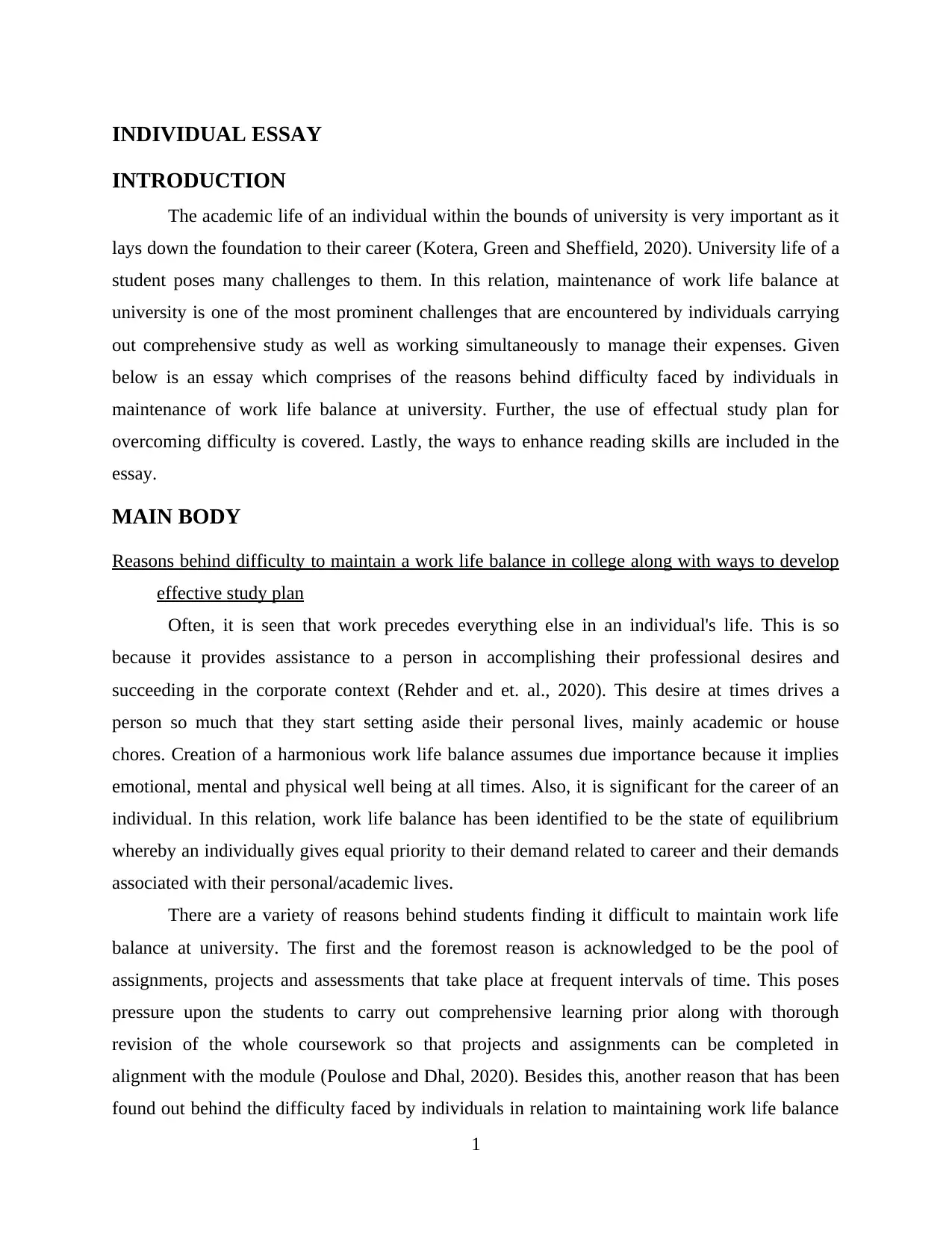
INDIVIDUAL ESSAY
INTRODUCTION
The academic life of an individual within the bounds of university is very important as it
lays down the foundation to their career (Kotera, Green and Sheffield, 2020). University life of a
student poses many challenges to them. In this relation, maintenance of work life balance at
university is one of the most prominent challenges that are encountered by individuals carrying
out comprehensive study as well as working simultaneously to manage their expenses. Given
below is an essay which comprises of the reasons behind difficulty faced by individuals in
maintenance of work life balance at university. Further, the use of effectual study plan for
overcoming difficulty is covered. Lastly, the ways to enhance reading skills are included in the
essay.
MAIN BODY
Reasons behind difficulty to maintain a work life balance in college along with ways to develop
effective study plan
Often, it is seen that work precedes everything else in an individual's life. This is so
because it provides assistance to a person in accomplishing their professional desires and
succeeding in the corporate context (Rehder and et. al., 2020). This desire at times drives a
person so much that they start setting aside their personal lives, mainly academic or house
chores. Creation of a harmonious work life balance assumes due importance because it implies
emotional, mental and physical well being at all times. Also, it is significant for the career of an
individual. In this relation, work life balance has been identified to be the state of equilibrium
whereby an individually gives equal priority to their demand related to career and their demands
associated with their personal/academic lives.
There are a variety of reasons behind students finding it difficult to maintain work life
balance at university. The first and the foremost reason is acknowledged to be the pool of
assignments, projects and assessments that take place at frequent intervals of time. This poses
pressure upon the students to carry out comprehensive learning prior along with thorough
revision of the whole coursework so that projects and assignments can be completed in
alignment with the module (Poulose and Dhal, 2020). Besides this, another reason that has been
found out behind the difficulty faced by individuals in relation to maintaining work life balance
1
INTRODUCTION
The academic life of an individual within the bounds of university is very important as it
lays down the foundation to their career (Kotera, Green and Sheffield, 2020). University life of a
student poses many challenges to them. In this relation, maintenance of work life balance at
university is one of the most prominent challenges that are encountered by individuals carrying
out comprehensive study as well as working simultaneously to manage their expenses. Given
below is an essay which comprises of the reasons behind difficulty faced by individuals in
maintenance of work life balance at university. Further, the use of effectual study plan for
overcoming difficulty is covered. Lastly, the ways to enhance reading skills are included in the
essay.
MAIN BODY
Reasons behind difficulty to maintain a work life balance in college along with ways to develop
effective study plan
Often, it is seen that work precedes everything else in an individual's life. This is so
because it provides assistance to a person in accomplishing their professional desires and
succeeding in the corporate context (Rehder and et. al., 2020). This desire at times drives a
person so much that they start setting aside their personal lives, mainly academic or house
chores. Creation of a harmonious work life balance assumes due importance because it implies
emotional, mental and physical well being at all times. Also, it is significant for the career of an
individual. In this relation, work life balance has been identified to be the state of equilibrium
whereby an individually gives equal priority to their demand related to career and their demands
associated with their personal/academic lives.
There are a variety of reasons behind students finding it difficult to maintain work life
balance at university. The first and the foremost reason is acknowledged to be the pool of
assignments, projects and assessments that take place at frequent intervals of time. This poses
pressure upon the students to carry out comprehensive learning prior along with thorough
revision of the whole coursework so that projects and assignments can be completed in
alignment with the module (Poulose and Dhal, 2020). Besides this, another reason that has been
found out behind the difficulty faced by individuals in relation to maintaining work life balance
1
⊘ This is a preview!⊘
Do you want full access?
Subscribe today to unlock all pages.

Trusted by 1+ million students worldwide
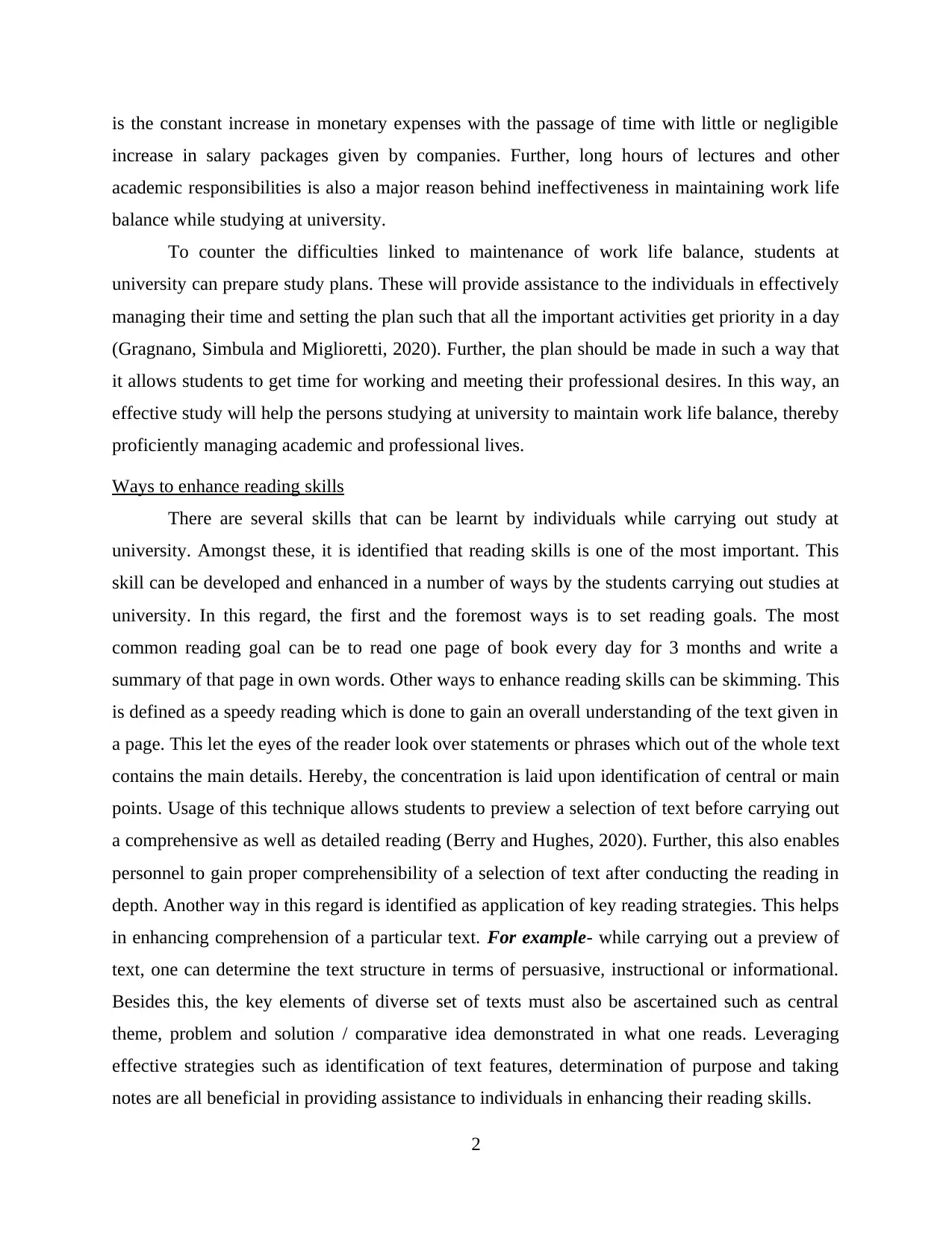
is the constant increase in monetary expenses with the passage of time with little or negligible
increase in salary packages given by companies. Further, long hours of lectures and other
academic responsibilities is also a major reason behind ineffectiveness in maintaining work life
balance while studying at university.
To counter the difficulties linked to maintenance of work life balance, students at
university can prepare study plans. These will provide assistance to the individuals in effectively
managing their time and setting the plan such that all the important activities get priority in a day
(Gragnano, Simbula and Miglioretti, 2020). Further, the plan should be made in such a way that
it allows students to get time for working and meeting their professional desires. In this way, an
effective study will help the persons studying at university to maintain work life balance, thereby
proficiently managing academic and professional lives.
Ways to enhance reading skills
There are several skills that can be learnt by individuals while carrying out study at
university. Amongst these, it is identified that reading skills is one of the most important. This
skill can be developed and enhanced in a number of ways by the students carrying out studies at
university. In this regard, the first and the foremost ways is to set reading goals. The most
common reading goal can be to read one page of book every day for 3 months and write a
summary of that page in own words. Other ways to enhance reading skills can be skimming. This
is defined as a speedy reading which is done to gain an overall understanding of the text given in
a page. This let the eyes of the reader look over statements or phrases which out of the whole text
contains the main details. Hereby, the concentration is laid upon identification of central or main
points. Usage of this technique allows students to preview a selection of text before carrying out
a comprehensive as well as detailed reading (Berry and Hughes, 2020). Further, this also enables
personnel to gain proper comprehensibility of a selection of text after conducting the reading in
depth. Another way in this regard is identified as application of key reading strategies. This helps
in enhancing comprehension of a particular text. For example- while carrying out a preview of
text, one can determine the text structure in terms of persuasive, instructional or informational.
Besides this, the key elements of diverse set of texts must also be ascertained such as central
theme, problem and solution / comparative idea demonstrated in what one reads. Leveraging
effective strategies such as identification of text features, determination of purpose and taking
notes are all beneficial in providing assistance to individuals in enhancing their reading skills.
2
increase in salary packages given by companies. Further, long hours of lectures and other
academic responsibilities is also a major reason behind ineffectiveness in maintaining work life
balance while studying at university.
To counter the difficulties linked to maintenance of work life balance, students at
university can prepare study plans. These will provide assistance to the individuals in effectively
managing their time and setting the plan such that all the important activities get priority in a day
(Gragnano, Simbula and Miglioretti, 2020). Further, the plan should be made in such a way that
it allows students to get time for working and meeting their professional desires. In this way, an
effective study will help the persons studying at university to maintain work life balance, thereby
proficiently managing academic and professional lives.
Ways to enhance reading skills
There are several skills that can be learnt by individuals while carrying out study at
university. Amongst these, it is identified that reading skills is one of the most important. This
skill can be developed and enhanced in a number of ways by the students carrying out studies at
university. In this regard, the first and the foremost ways is to set reading goals. The most
common reading goal can be to read one page of book every day for 3 months and write a
summary of that page in own words. Other ways to enhance reading skills can be skimming. This
is defined as a speedy reading which is done to gain an overall understanding of the text given in
a page. This let the eyes of the reader look over statements or phrases which out of the whole text
contains the main details. Hereby, the concentration is laid upon identification of central or main
points. Usage of this technique allows students to preview a selection of text before carrying out
a comprehensive as well as detailed reading (Berry and Hughes, 2020). Further, this also enables
personnel to gain proper comprehensibility of a selection of text after conducting the reading in
depth. Another way in this regard is identified as application of key reading strategies. This helps
in enhancing comprehension of a particular text. For example- while carrying out a preview of
text, one can determine the text structure in terms of persuasive, instructional or informational.
Besides this, the key elements of diverse set of texts must also be ascertained such as central
theme, problem and solution / comparative idea demonstrated in what one reads. Leveraging
effective strategies such as identification of text features, determination of purpose and taking
notes are all beneficial in providing assistance to individuals in enhancing their reading skills.
2
Paraphrase This Document
Need a fresh take? Get an instant paraphrase of this document with our AI Paraphraser
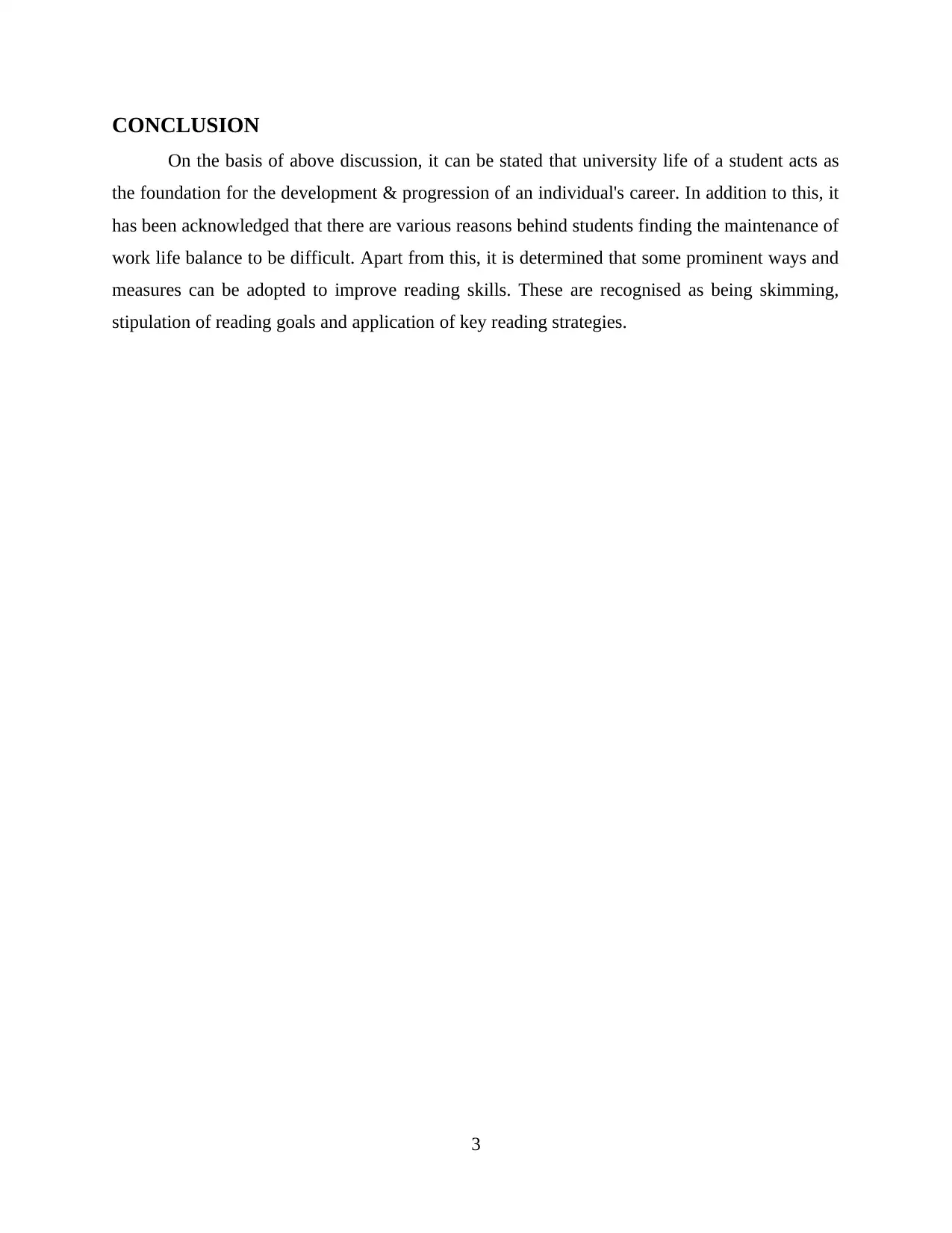
CONCLUSION
On the basis of above discussion, it can be stated that university life of a student acts as
the foundation for the development & progression of an individual's career. In addition to this, it
has been acknowledged that there are various reasons behind students finding the maintenance of
work life balance to be difficult. Apart from this, it is determined that some prominent ways and
measures can be adopted to improve reading skills. These are recognised as being skimming,
stipulation of reading goals and application of key reading strategies.
3
On the basis of above discussion, it can be stated that university life of a student acts as
the foundation for the development & progression of an individual's career. In addition to this, it
has been acknowledged that there are various reasons behind students finding the maintenance of
work life balance to be difficult. Apart from this, it is determined that some prominent ways and
measures can be adopted to improve reading skills. These are recognised as being skimming,
stipulation of reading goals and application of key reading strategies.
3
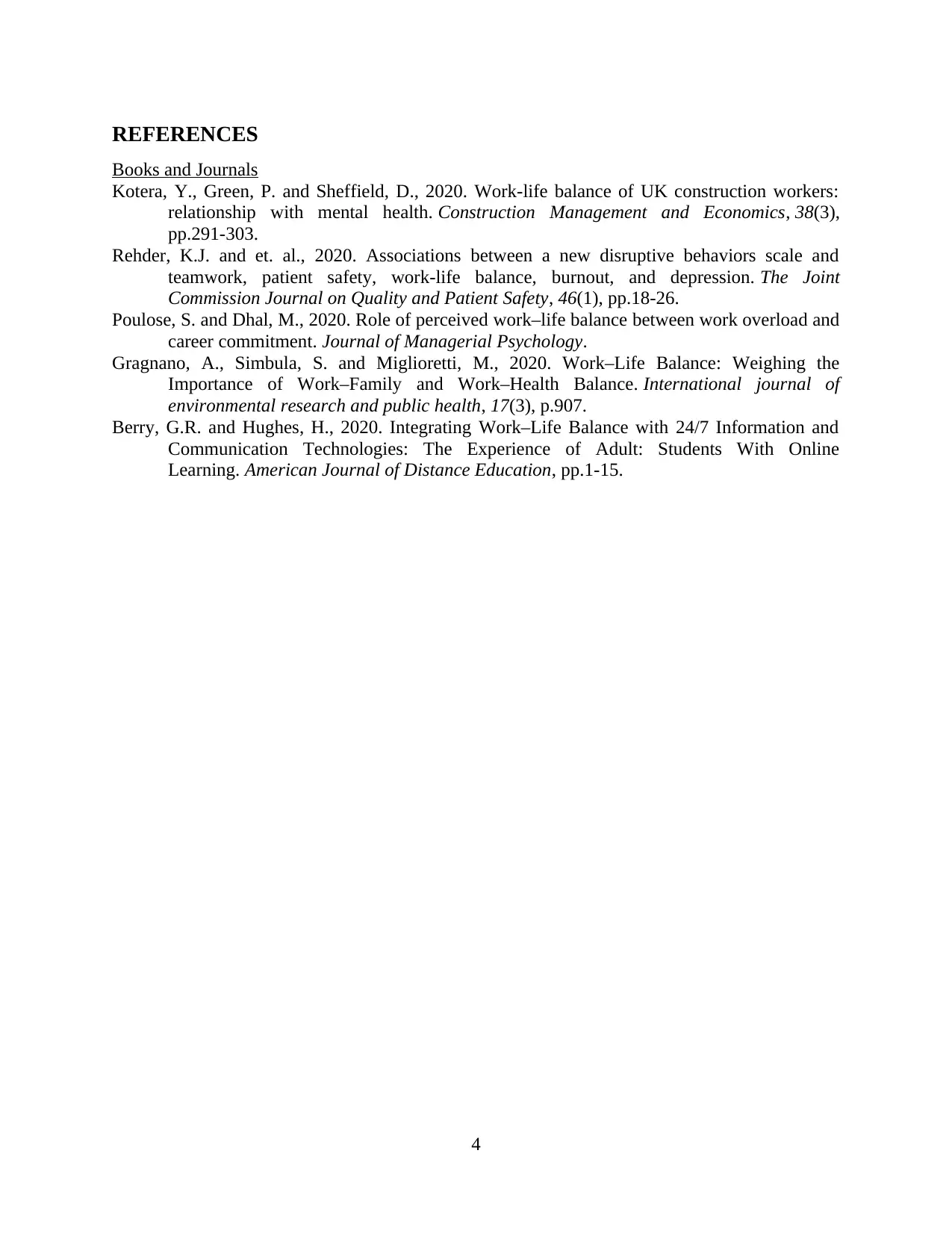
REFERENCES
Books and Journals
Kotera, Y., Green, P. and Sheffield, D., 2020. Work-life balance of UK construction workers:
relationship with mental health. Construction Management and Economics, 38(3),
pp.291-303.
Rehder, K.J. and et. al., 2020. Associations between a new disruptive behaviors scale and
teamwork, patient safety, work-life balance, burnout, and depression. The Joint
Commission Journal on Quality and Patient Safety, 46(1), pp.18-26.
Poulose, S. and Dhal, M., 2020. Role of perceived work–life balance between work overload and
career commitment. Journal of Managerial Psychology.
Gragnano, A., Simbula, S. and Miglioretti, M., 2020. Work–Life Balance: Weighing the
Importance of Work–Family and Work–Health Balance. International journal of
environmental research and public health, 17(3), p.907.
Berry, G.R. and Hughes, H., 2020. Integrating Work–Life Balance with 24/7 Information and
Communication Technologies: The Experience of Adult: Students With Online
Learning. American Journal of Distance Education, pp.1-15.
4
Books and Journals
Kotera, Y., Green, P. and Sheffield, D., 2020. Work-life balance of UK construction workers:
relationship with mental health. Construction Management and Economics, 38(3),
pp.291-303.
Rehder, K.J. and et. al., 2020. Associations between a new disruptive behaviors scale and
teamwork, patient safety, work-life balance, burnout, and depression. The Joint
Commission Journal on Quality and Patient Safety, 46(1), pp.18-26.
Poulose, S. and Dhal, M., 2020. Role of perceived work–life balance between work overload and
career commitment. Journal of Managerial Psychology.
Gragnano, A., Simbula, S. and Miglioretti, M., 2020. Work–Life Balance: Weighing the
Importance of Work–Family and Work–Health Balance. International journal of
environmental research and public health, 17(3), p.907.
Berry, G.R. and Hughes, H., 2020. Integrating Work–Life Balance with 24/7 Information and
Communication Technologies: The Experience of Adult: Students With Online
Learning. American Journal of Distance Education, pp.1-15.
4
⊘ This is a preview!⊘
Do you want full access?
Subscribe today to unlock all pages.

Trusted by 1+ million students worldwide
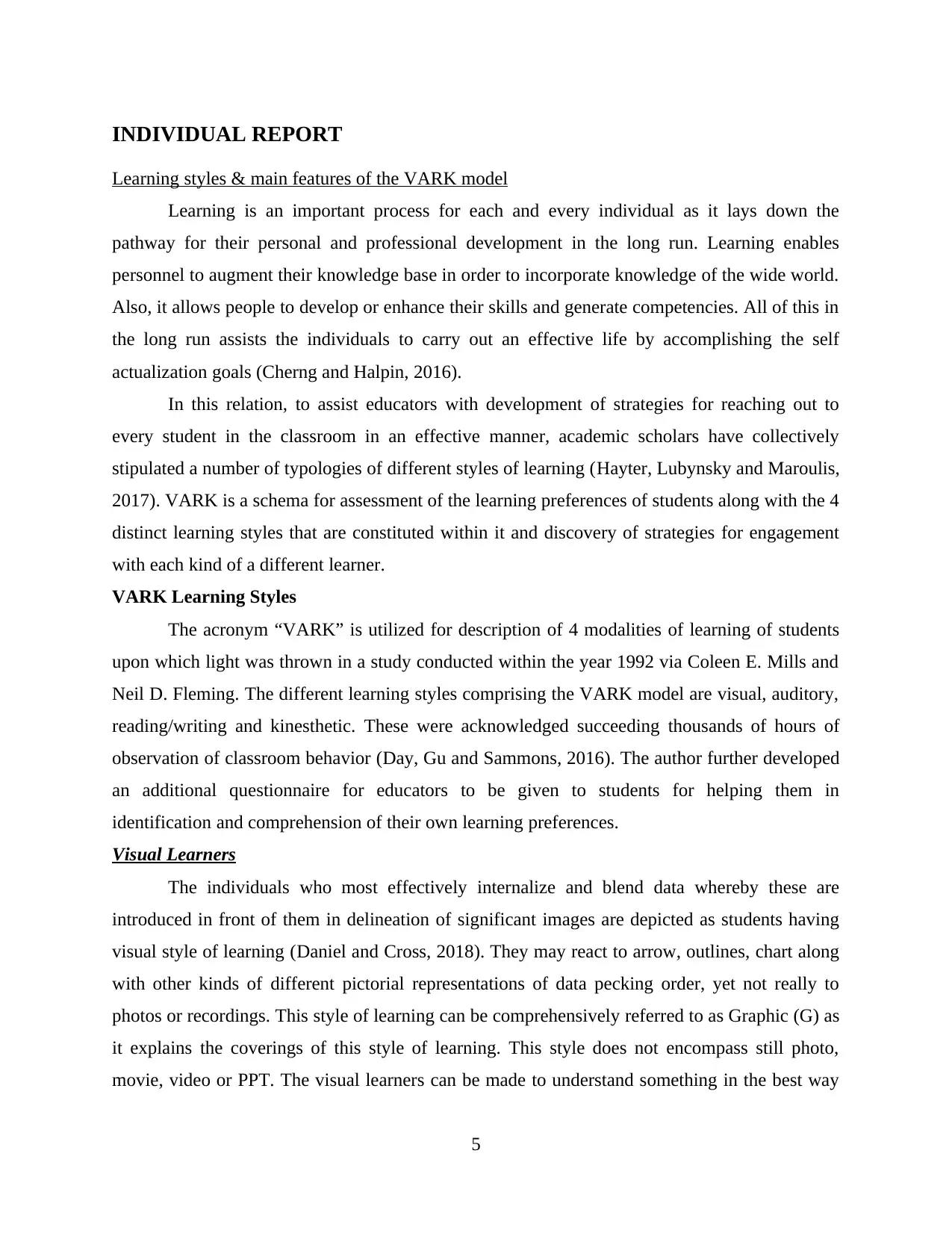
INDIVIDUAL REPORT
Learning styles & main features of the VARK model
Learning is an important process for each and every individual as it lays down the
pathway for their personal and professional development in the long run. Learning enables
personnel to augment their knowledge base in order to incorporate knowledge of the wide world.
Also, it allows people to develop or enhance their skills and generate competencies. All of this in
the long run assists the individuals to carry out an effective life by accomplishing the self
actualization goals (Cherng and Halpin, 2016).
In this relation, to assist educators with development of strategies for reaching out to
every student in the classroom in an effective manner, academic scholars have collectively
stipulated a number of typologies of different styles of learning (Hayter, Lubynsky and Maroulis,
2017). VARK is a schema for assessment of the learning preferences of students along with the 4
distinct learning styles that are constituted within it and discovery of strategies for engagement
with each kind of a different learner.
VARK Learning Styles
The acronym “VARK” is utilized for description of 4 modalities of learning of students
upon which light was thrown in a study conducted within the year 1992 via Coleen E. Mills and
Neil D. Fleming. The different learning styles comprising the VARK model are visual, auditory,
reading/writing and kinesthetic. These were acknowledged succeeding thousands of hours of
observation of classroom behavior (Day, Gu and Sammons, 2016). The author further developed
an additional questionnaire for educators to be given to students for helping them in
identification and comprehension of their own learning preferences.
Visual Learners
The individuals who most effectively internalize and blend data whereby these are
introduced in front of them in delineation of significant images are depicted as students having
visual style of learning (Daniel and Cross, 2018). They may react to arrow, outlines, chart along
with other kinds of different pictorial representations of data pecking order, yet not really to
photos or recordings. This style of learning can be comprehensively referred to as Graphic (G) as
it explains the coverings of this style of learning. This style does not encompass still photo,
movie, video or PPT. The visual learners can be made to understand something in the best way
5
Learning styles & main features of the VARK model
Learning is an important process for each and every individual as it lays down the
pathway for their personal and professional development in the long run. Learning enables
personnel to augment their knowledge base in order to incorporate knowledge of the wide world.
Also, it allows people to develop or enhance their skills and generate competencies. All of this in
the long run assists the individuals to carry out an effective life by accomplishing the self
actualization goals (Cherng and Halpin, 2016).
In this relation, to assist educators with development of strategies for reaching out to
every student in the classroom in an effective manner, academic scholars have collectively
stipulated a number of typologies of different styles of learning (Hayter, Lubynsky and Maroulis,
2017). VARK is a schema for assessment of the learning preferences of students along with the 4
distinct learning styles that are constituted within it and discovery of strategies for engagement
with each kind of a different learner.
VARK Learning Styles
The acronym “VARK” is utilized for description of 4 modalities of learning of students
upon which light was thrown in a study conducted within the year 1992 via Coleen E. Mills and
Neil D. Fleming. The different learning styles comprising the VARK model are visual, auditory,
reading/writing and kinesthetic. These were acknowledged succeeding thousands of hours of
observation of classroom behavior (Day, Gu and Sammons, 2016). The author further developed
an additional questionnaire for educators to be given to students for helping them in
identification and comprehension of their own learning preferences.
Visual Learners
The individuals who most effectively internalize and blend data whereby these are
introduced in front of them in delineation of significant images are depicted as students having
visual style of learning (Daniel and Cross, 2018). They may react to arrow, outlines, chart along
with other kinds of different pictorial representations of data pecking order, yet not really to
photos or recordings. This style of learning can be comprehensively referred to as Graphic (G) as
it explains the coverings of this style of learning. This style does not encompass still photo,
movie, video or PPT. The visual learners can be made to understand something in the best way
5
Paraphrase This Document
Need a fresh take? Get an instant paraphrase of this document with our AI Paraphraser
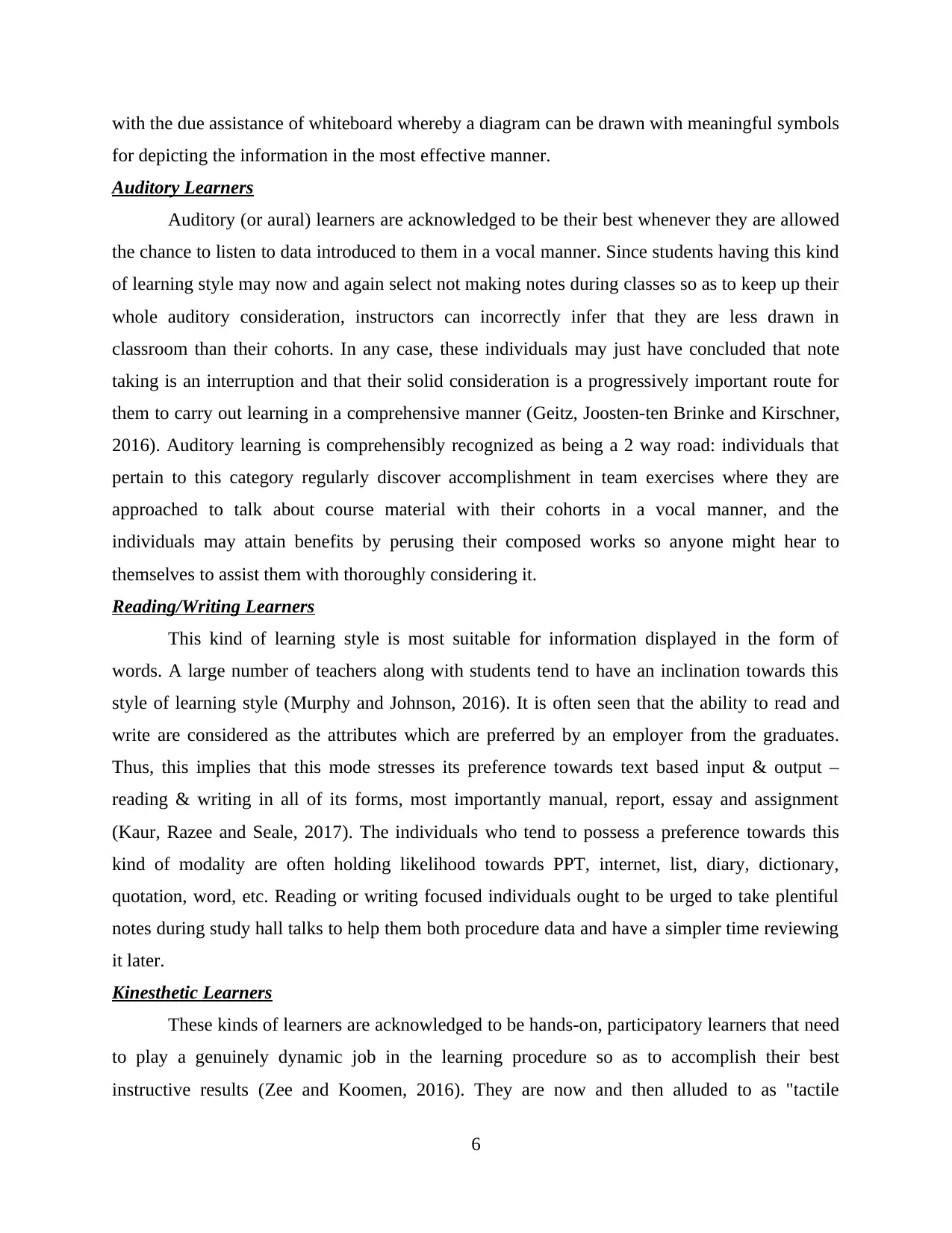
with the due assistance of whiteboard whereby a diagram can be drawn with meaningful symbols
for depicting the information in the most effective manner.
Auditory Learners
Auditory (or aural) learners are acknowledged to be their best whenever they are allowed
the chance to listen to data introduced to them in a vocal manner. Since students having this kind
of learning style may now and again select not making notes during classes so as to keep up their
whole auditory consideration, instructors can incorrectly infer that they are less drawn in
classroom than their cohorts. In any case, these individuals may just have concluded that note
taking is an interruption and that their solid consideration is a progressively important route for
them to carry out learning in a comprehensive manner (Geitz, Joosten-ten Brinke and Kirschner,
2016). Auditory learning is comprehensibly recognized as being a 2 way road: individuals that
pertain to this category regularly discover accomplishment in team exercises where they are
approached to talk about course material with their cohorts in a vocal manner, and the
individuals may attain benefits by perusing their composed works so anyone might hear to
themselves to assist them with thoroughly considering it.
Reading/Writing Learners
This kind of learning style is most suitable for information displayed in the form of
words. A large number of teachers along with students tend to have an inclination towards this
style of learning style (Murphy and Johnson, 2016). It is often seen that the ability to read and
write are considered as the attributes which are preferred by an employer from the graduates.
Thus, this implies that this mode stresses its preference towards text based input & output –
reading & writing in all of its forms, most importantly manual, report, essay and assignment
(Kaur, Razee and Seale, 2017). The individuals who tend to possess a preference towards this
kind of modality are often holding likelihood towards PPT, internet, list, diary, dictionary,
quotation, word, etc. Reading or writing focused individuals ought to be urged to take plentiful
notes during study hall talks to help them both procedure data and have a simpler time reviewing
it later.
Kinesthetic Learners
These kinds of learners are acknowledged to be hands-on, participatory learners that need
to play a genuinely dynamic job in the learning procedure so as to accomplish their best
instructive results (Zee and Koomen, 2016). They are now and then alluded to as "tactile
6
for depicting the information in the most effective manner.
Auditory Learners
Auditory (or aural) learners are acknowledged to be their best whenever they are allowed
the chance to listen to data introduced to them in a vocal manner. Since students having this kind
of learning style may now and again select not making notes during classes so as to keep up their
whole auditory consideration, instructors can incorrectly infer that they are less drawn in
classroom than their cohorts. In any case, these individuals may just have concluded that note
taking is an interruption and that their solid consideration is a progressively important route for
them to carry out learning in a comprehensive manner (Geitz, Joosten-ten Brinke and Kirschner,
2016). Auditory learning is comprehensibly recognized as being a 2 way road: individuals that
pertain to this category regularly discover accomplishment in team exercises where they are
approached to talk about course material with their cohorts in a vocal manner, and the
individuals may attain benefits by perusing their composed works so anyone might hear to
themselves to assist them with thoroughly considering it.
Reading/Writing Learners
This kind of learning style is most suitable for information displayed in the form of
words. A large number of teachers along with students tend to have an inclination towards this
style of learning style (Murphy and Johnson, 2016). It is often seen that the ability to read and
write are considered as the attributes which are preferred by an employer from the graduates.
Thus, this implies that this mode stresses its preference towards text based input & output –
reading & writing in all of its forms, most importantly manual, report, essay and assignment
(Kaur, Razee and Seale, 2017). The individuals who tend to possess a preference towards this
kind of modality are often holding likelihood towards PPT, internet, list, diary, dictionary,
quotation, word, etc. Reading or writing focused individuals ought to be urged to take plentiful
notes during study hall talks to help them both procedure data and have a simpler time reviewing
it later.
Kinesthetic Learners
These kinds of learners are acknowledged to be hands-on, participatory learners that need
to play a genuinely dynamic job in the learning procedure so as to accomplish their best
instructive results (Zee and Koomen, 2016). They are now and then alluded to as "tactile
6
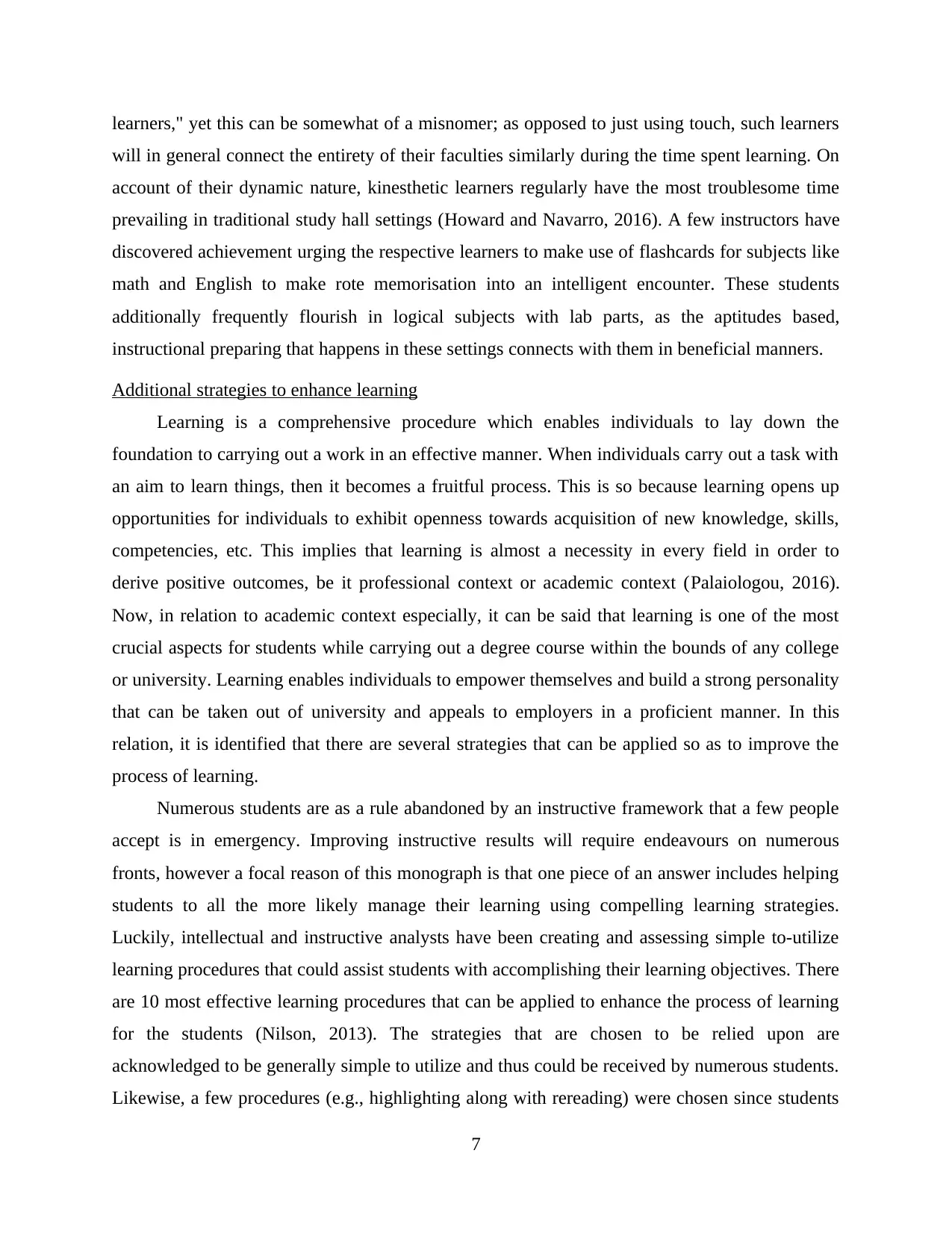
learners," yet this can be somewhat of a misnomer; as opposed to just using touch, such learners
will in general connect the entirety of their faculties similarly during the time spent learning. On
account of their dynamic nature, kinesthetic learners regularly have the most troublesome time
prevailing in traditional study hall settings (Howard and Navarro, 2016). A few instructors have
discovered achievement urging the respective learners to make use of flashcards for subjects like
math and English to make rote memorisation into an intelligent encounter. These students
additionally frequently flourish in logical subjects with lab parts, as the aptitudes based,
instructional preparing that happens in these settings connects with them in beneficial manners.
Additional strategies to enhance learning
Learning is a comprehensive procedure which enables individuals to lay down the
foundation to carrying out a work in an effective manner. When individuals carry out a task with
an aim to learn things, then it becomes a fruitful process. This is so because learning opens up
opportunities for individuals to exhibit openness towards acquisition of new knowledge, skills,
competencies, etc. This implies that learning is almost a necessity in every field in order to
derive positive outcomes, be it professional context or academic context (Palaiologou, 2016).
Now, in relation to academic context especially, it can be said that learning is one of the most
crucial aspects for students while carrying out a degree course within the bounds of any college
or university. Learning enables individuals to empower themselves and build a strong personality
that can be taken out of university and appeals to employers in a proficient manner. In this
relation, it is identified that there are several strategies that can be applied so as to improve the
process of learning.
Numerous students are as a rule abandoned by an instructive framework that a few people
accept is in emergency. Improving instructive results will require endeavours on numerous
fronts, however a focal reason of this monograph is that one piece of an answer includes helping
students to all the more likely manage their learning using compelling learning strategies.
Luckily, intellectual and instructive analysts have been creating and assessing simple to-utilize
learning procedures that could assist students with accomplishing their learning objectives. There
are 10 most effective learning procedures that can be applied to enhance the process of learning
for the students (Nilson, 2013). The strategies that are chosen to be relied upon are
acknowledged to be generally simple to utilize and thus could be received by numerous students.
Likewise, a few procedures (e.g., highlighting along with rereading) were chosen since students
7
will in general connect the entirety of their faculties similarly during the time spent learning. On
account of their dynamic nature, kinesthetic learners regularly have the most troublesome time
prevailing in traditional study hall settings (Howard and Navarro, 2016). A few instructors have
discovered achievement urging the respective learners to make use of flashcards for subjects like
math and English to make rote memorisation into an intelligent encounter. These students
additionally frequently flourish in logical subjects with lab parts, as the aptitudes based,
instructional preparing that happens in these settings connects with them in beneficial manners.
Additional strategies to enhance learning
Learning is a comprehensive procedure which enables individuals to lay down the
foundation to carrying out a work in an effective manner. When individuals carry out a task with
an aim to learn things, then it becomes a fruitful process. This is so because learning opens up
opportunities for individuals to exhibit openness towards acquisition of new knowledge, skills,
competencies, etc. This implies that learning is almost a necessity in every field in order to
derive positive outcomes, be it professional context or academic context (Palaiologou, 2016).
Now, in relation to academic context especially, it can be said that learning is one of the most
crucial aspects for students while carrying out a degree course within the bounds of any college
or university. Learning enables individuals to empower themselves and build a strong personality
that can be taken out of university and appeals to employers in a proficient manner. In this
relation, it is identified that there are several strategies that can be applied so as to improve the
process of learning.
Numerous students are as a rule abandoned by an instructive framework that a few people
accept is in emergency. Improving instructive results will require endeavours on numerous
fronts, however a focal reason of this monograph is that one piece of an answer includes helping
students to all the more likely manage their learning using compelling learning strategies.
Luckily, intellectual and instructive analysts have been creating and assessing simple to-utilize
learning procedures that could assist students with accomplishing their learning objectives. There
are 10 most effective learning procedures that can be applied to enhance the process of learning
for the students (Nilson, 2013). The strategies that are chosen to be relied upon are
acknowledged to be generally simple to utilize and thus could be received by numerous students.
Likewise, a few procedures (e.g., highlighting along with rereading) were chosen since students
7
⊘ This is a preview!⊘
Do you want full access?
Subscribe today to unlock all pages.

Trusted by 1+ million students worldwide
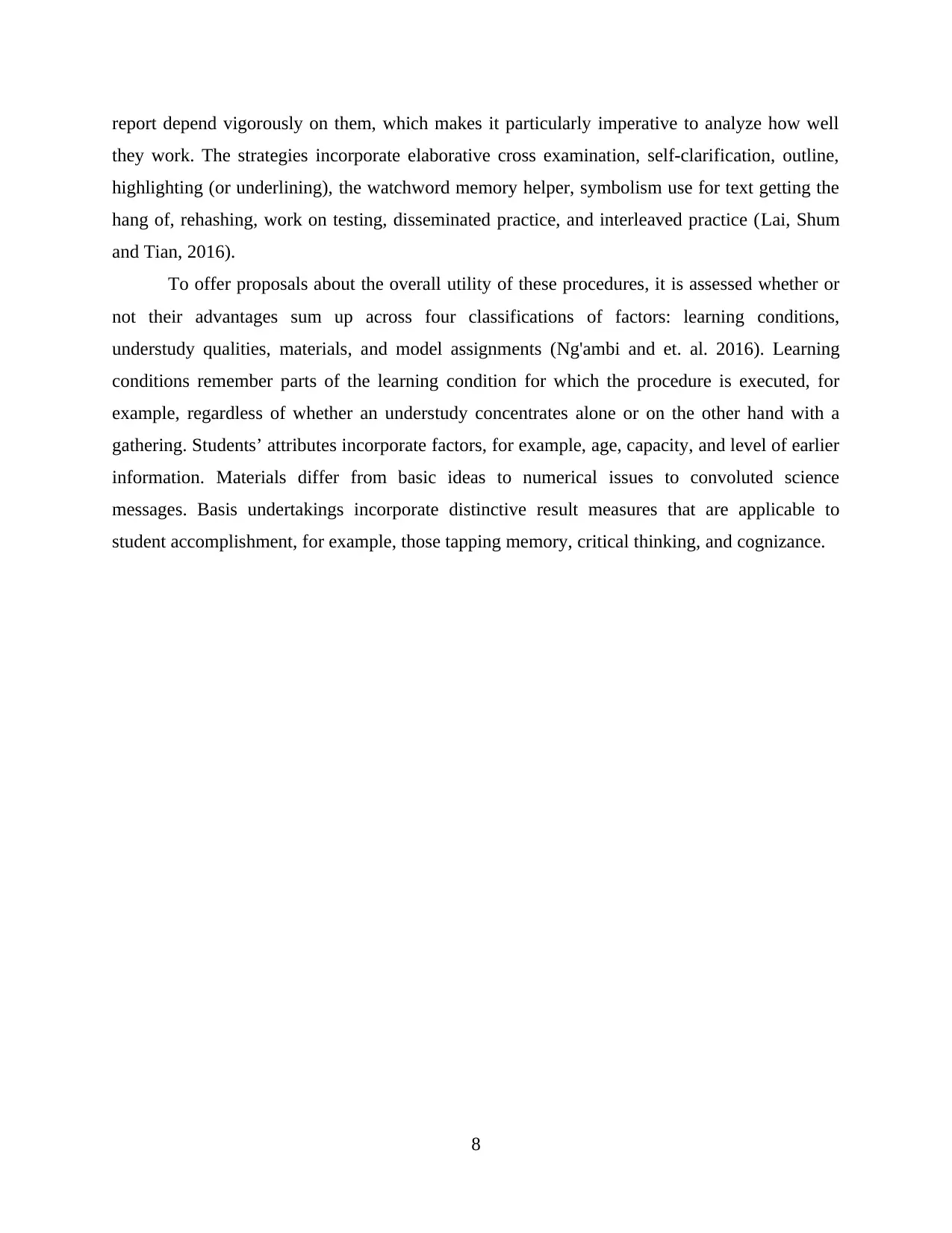
report depend vigorously on them, which makes it particularly imperative to analyze how well
they work. The strategies incorporate elaborative cross examination, self-clarification, outline,
highlighting (or underlining), the watchword memory helper, symbolism use for text getting the
hang of, rehashing, work on testing, disseminated practice, and interleaved practice (Lai, Shum
and Tian, 2016).
To offer proposals about the overall utility of these procedures, it is assessed whether or
not their advantages sum up across four classifications of factors: learning conditions,
understudy qualities, materials, and model assignments (Ng'ambi and et. al. 2016). Learning
conditions remember parts of the learning condition for which the procedure is executed, for
example, regardless of whether an understudy concentrates alone or on the other hand with a
gathering. Students’ attributes incorporate factors, for example, age, capacity, and level of earlier
information. Materials differ from basic ideas to numerical issues to convoluted science
messages. Basis undertakings incorporate distinctive result measures that are applicable to
student accomplishment, for example, those tapping memory, critical thinking, and cognizance.
8
they work. The strategies incorporate elaborative cross examination, self-clarification, outline,
highlighting (or underlining), the watchword memory helper, symbolism use for text getting the
hang of, rehashing, work on testing, disseminated practice, and interleaved practice (Lai, Shum
and Tian, 2016).
To offer proposals about the overall utility of these procedures, it is assessed whether or
not their advantages sum up across four classifications of factors: learning conditions,
understudy qualities, materials, and model assignments (Ng'ambi and et. al. 2016). Learning
conditions remember parts of the learning condition for which the procedure is executed, for
example, regardless of whether an understudy concentrates alone or on the other hand with a
gathering. Students’ attributes incorporate factors, for example, age, capacity, and level of earlier
information. Materials differ from basic ideas to numerical issues to convoluted science
messages. Basis undertakings incorporate distinctive result measures that are applicable to
student accomplishment, for example, those tapping memory, critical thinking, and cognizance.
8
Paraphrase This Document
Need a fresh take? Get an instant paraphrase of this document with our AI Paraphraser
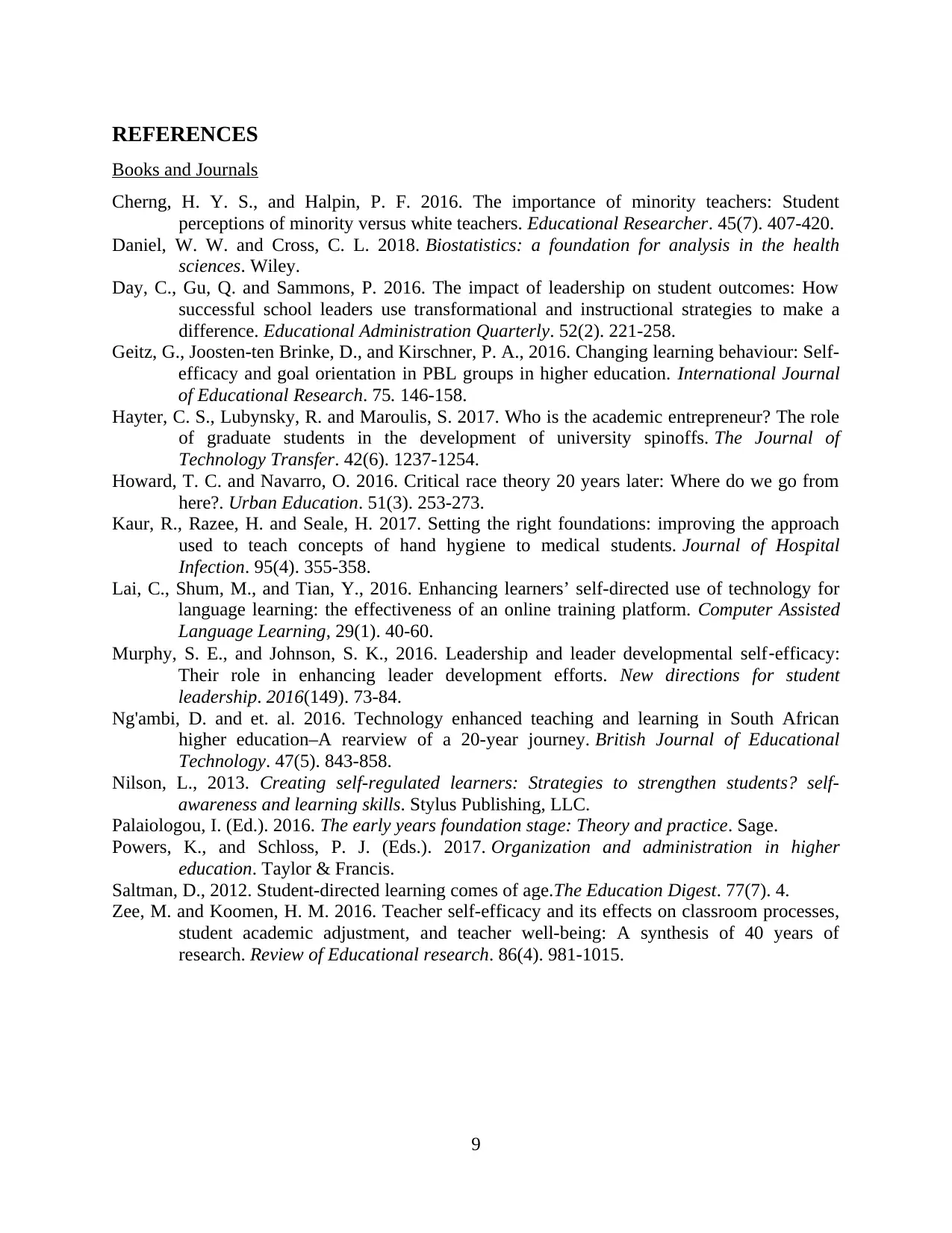
REFERENCES
Books and Journals
Cherng, H. Y. S., and Halpin, P. F. 2016. The importance of minority teachers: Student
perceptions of minority versus white teachers. Educational Researcher. 45(7). 407-420.
Daniel, W. W. and Cross, C. L. 2018. Biostatistics: a foundation for analysis in the health
sciences. Wiley.
Day, C., Gu, Q. and Sammons, P. 2016. The impact of leadership on student outcomes: How
successful school leaders use transformational and instructional strategies to make a
difference. Educational Administration Quarterly. 52(2). 221-258.
Geitz, G., Joosten-ten Brinke, D., and Kirschner, P. A., 2016. Changing learning behaviour: Self-
efficacy and goal orientation in PBL groups in higher education. International Journal
of Educational Research. 75. 146-158.
Hayter, C. S., Lubynsky, R. and Maroulis, S. 2017. Who is the academic entrepreneur? The role
of graduate students in the development of university spinoffs. The Journal of
Technology Transfer. 42(6). 1237-1254.
Howard, T. C. and Navarro, O. 2016. Critical race theory 20 years later: Where do we go from
here?. Urban Education. 51(3). 253-273.
Kaur, R., Razee, H. and Seale, H. 2017. Setting the right foundations: improving the approach
used to teach concepts of hand hygiene to medical students. Journal of Hospital
Infection. 95(4). 355-358.
Lai, C., Shum, M., and Tian, Y., 2016. Enhancing learners’ self-directed use of technology for
language learning: the effectiveness of an online training platform. Computer Assisted
Language Learning, 29(1). 40-60.
Murphy, S. E., and Johnson, S. K., 2016. Leadership and leader developmental self‐efficacy:
Their role in enhancing leader development efforts. New directions for student
leadership. 2016(149). 73-84.
Ng'ambi, D. and et. al. 2016. Technology enhanced teaching and learning in South African
higher education–A rearview of a 20-year journey. British Journal of Educational
Technology. 47(5). 843-858.
Nilson, L., 2013. Creating self-regulated learners: Strategies to strengthen students? self-
awareness and learning skills. Stylus Publishing, LLC.
Palaiologou, I. (Ed.). 2016. The early years foundation stage: Theory and practice. Sage.
Powers, K., and Schloss, P. J. (Eds.). 2017. Organization and administration in higher
education. Taylor & Francis.
Saltman, D., 2012. Student-directed learning comes of age.The Education Digest. 77(7). 4.
Zee, M. and Koomen, H. M. 2016. Teacher self-efficacy and its effects on classroom processes,
student academic adjustment, and teacher well-being: A synthesis of 40 years of
research. Review of Educational research. 86(4). 981-1015.
9
Books and Journals
Cherng, H. Y. S., and Halpin, P. F. 2016. The importance of minority teachers: Student
perceptions of minority versus white teachers. Educational Researcher. 45(7). 407-420.
Daniel, W. W. and Cross, C. L. 2018. Biostatistics: a foundation for analysis in the health
sciences. Wiley.
Day, C., Gu, Q. and Sammons, P. 2016. The impact of leadership on student outcomes: How
successful school leaders use transformational and instructional strategies to make a
difference. Educational Administration Quarterly. 52(2). 221-258.
Geitz, G., Joosten-ten Brinke, D., and Kirschner, P. A., 2016. Changing learning behaviour: Self-
efficacy and goal orientation in PBL groups in higher education. International Journal
of Educational Research. 75. 146-158.
Hayter, C. S., Lubynsky, R. and Maroulis, S. 2017. Who is the academic entrepreneur? The role
of graduate students in the development of university spinoffs. The Journal of
Technology Transfer. 42(6). 1237-1254.
Howard, T. C. and Navarro, O. 2016. Critical race theory 20 years later: Where do we go from
here?. Urban Education. 51(3). 253-273.
Kaur, R., Razee, H. and Seale, H. 2017. Setting the right foundations: improving the approach
used to teach concepts of hand hygiene to medical students. Journal of Hospital
Infection. 95(4). 355-358.
Lai, C., Shum, M., and Tian, Y., 2016. Enhancing learners’ self-directed use of technology for
language learning: the effectiveness of an online training platform. Computer Assisted
Language Learning, 29(1). 40-60.
Murphy, S. E., and Johnson, S. K., 2016. Leadership and leader developmental self‐efficacy:
Their role in enhancing leader development efforts. New directions for student
leadership. 2016(149). 73-84.
Ng'ambi, D. and et. al. 2016. Technology enhanced teaching and learning in South African
higher education–A rearview of a 20-year journey. British Journal of Educational
Technology. 47(5). 843-858.
Nilson, L., 2013. Creating self-regulated learners: Strategies to strengthen students? self-
awareness and learning skills. Stylus Publishing, LLC.
Palaiologou, I. (Ed.). 2016. The early years foundation stage: Theory and practice. Sage.
Powers, K., and Schloss, P. J. (Eds.). 2017. Organization and administration in higher
education. Taylor & Francis.
Saltman, D., 2012. Student-directed learning comes of age.The Education Digest. 77(7). 4.
Zee, M. and Koomen, H. M. 2016. Teacher self-efficacy and its effects on classroom processes,
student academic adjustment, and teacher well-being: A synthesis of 40 years of
research. Review of Educational research. 86(4). 981-1015.
9
1 out of 11
Related Documents
Your All-in-One AI-Powered Toolkit for Academic Success.
+13062052269
info@desklib.com
Available 24*7 on WhatsApp / Email
![[object Object]](/_next/static/media/star-bottom.7253800d.svg)
Unlock your academic potential
Copyright © 2020–2025 A2Z Services. All Rights Reserved. Developed and managed by ZUCOL.




